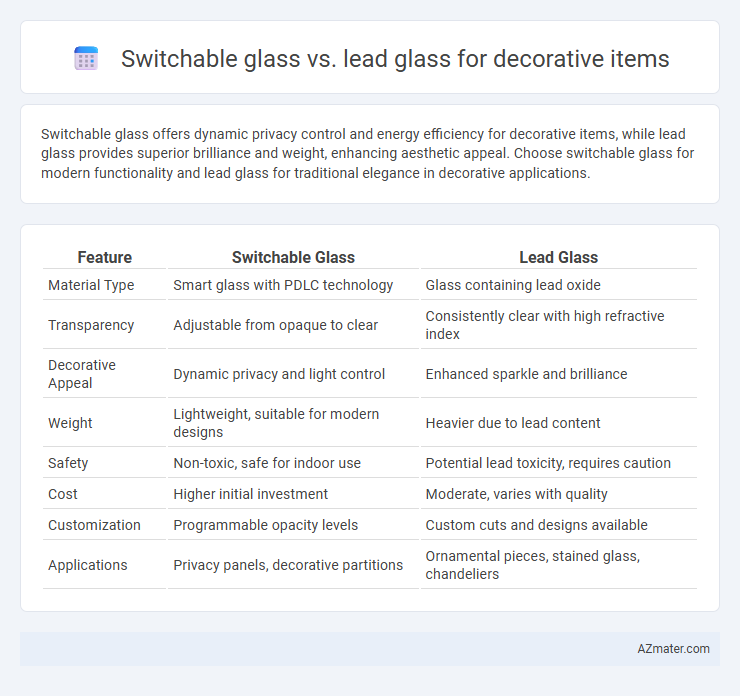Switchable glass offers dynamic privacy control and energy efficiency for decorative items, while lead glass provides superior brilliance and weight, enhancing aesthetic appeal. Choose switchable glass for modern functionality and lead glass for traditional elegance in decorative applications.
Table of Comparison
| Feature | Switchable Glass | Lead Glass |
|---|---|---|
| Material Type | Smart glass with PDLC technology | Glass containing lead oxide |
| Transparency | Adjustable from opaque to clear | Consistently clear with high refractive index |
| Decorative Appeal | Dynamic privacy and light control | Enhanced sparkle and brilliance |
| Weight | Lightweight, suitable for modern designs | Heavier due to lead content |
| Safety | Non-toxic, safe for indoor use | Potential lead toxicity, requires caution |
| Cost | Higher initial investment | Moderate, varies with quality |
| Customization | Programmable opacity levels | Custom cuts and designs available |
| Applications | Privacy panels, decorative partitions | Ornamental pieces, stained glass, chandeliers |
Introduction to Decorative Glass: Switchable vs Lead Glass
Switchable glass uses liquid crystal technology to change transparency on demand, offering versatility in decorative items with privacy control and dynamic visual effects. Lead glass, known for its high refractive index and brilliance, enhances decorative pieces with sparkling clarity and traditional luxury appeal. Selecting between switchable and lead glass depends on desired functionality, aesthetic impact, and application environment.
Composition and Properties of Switchable Glass
Switchable glass, also known as smart glass, is primarily composed of liquid crystal or polymer dispersed liquid crystals embedded between two glass layers, allowing it to change from transparent to opaque when an electric current is applied. This dynamic optical property provides enhanced privacy and energy efficiency, making it ideal for decorative items that require variable light control. In contrast, lead glass contains high concentrations of lead oxide, offering superior weight, brilliance, and refractive qualities but lacks the adaptive transparency characteristics of switchable glass.
Unique Features of Lead Glass in Decor
Lead glass features exceptional clarity and brilliance due to its high refractive index, making decorative items visually striking with vibrant light reflection and refraction. Its superior weight and density provide a substantial, luxurious feel ideal for premium decor elements. The material's ability to be intricately cut and engraved enhances its artistic versatility, setting it apart from switchable glass in ornamental applications.
Aesthetic Appeal: Comparing Visual Effects
Switchable glass offers dynamic transparency control, allowing users to alternate between clear and frosted states, enhancing interior aesthetics by providing customizable privacy and light diffusion. Lead glass, known for its high refractive index and brilliance, creates striking decorative items with vibrant light dispersion and intricate visual patterns. The choice between switchable glass and lead glass hinges on whether one prioritizes interactive visual effects or timeless, sparkling elegance in decorative design.
Customization Options for Decorative Applications
Switchable glass offers dynamic customization options for decorative applications, allowing users to control transparency, opacity, and color through electrical activation, making it ideal for privacy and aesthetic flexibility. Lead glass, known for its high refractive index and brilliant clarity, allows intricate designs and engraving but lacks the adaptive features of switchable glass. Customization in switchable glass extends to patterns, sizes, and tint levels, providing versatile solutions for modern decorative needs compared to the static elegance of traditional lead glass.
Durability and Maintenance Considerations
Switchable glass offers enhanced durability due to its laminated structure, which resists scratches and impacts more effectively than lead glass commonly used in decorative items. Maintenance of switchable glass is simplified by its smooth, non-porous surface that prevents dirt accumulation and staining, unlike lead glass that often requires careful cleaning to avoid damage. Long-term durability also favors switchable glass, as it resists yellowing and degradation from UV exposure, a common issue with lead glass in decorative applications.
Environmental and Safety Impacts
Switchable glass offers enhanced environmental benefits by reducing energy consumption through its ability to control solar heat gain, which lowers cooling costs and decreases carbon emissions compared to traditional lead glass. Lead glass poses significant safety concerns due to its toxic lead content, which can leach into the environment during manufacturing, disposal, or if broken, creating hazardous exposure risks. Switchable glass is also non-toxic and recyclable, making it a safer and more sustainable choice for decorative items focused on reducing environmental impact and promoting user safety.
Cost Analysis: Switchable Glass vs Lead Glass
Switchable glass typically incurs higher initial costs than lead glass due to advanced technology and installation requirements, with prices ranging from $100 to $150 per square foot compared to lead glass's $50 to $120 per square foot. Maintenance expenses for switchable glass can also be greater over time, driven by electronic components and potential repairs, while lead glass requires minimal upkeep. Considering long-term value, lead glass offers cheaper upfront costs and durability, whereas switchable glass provides innovative features that may justify the premium depending on project specifications.
Popular Decorative Uses in Modern Interiors
Switchable glass, with its ability to transition between transparent and opaque states, is increasingly popular in modern interiors for decorative partitions, smart windows, and privacy screens, offering both style and functionality. Lead glass is prized for its brilliance and weight, making it a favored choice for ornamental vases, chandeliers, and intricate art pieces that add elegance and a vintage charm. Both materials serve distinct decorative purposes, with switchable glass emphasizing versatility and innovation, while lead glass highlights craftsmanship and classical beauty.
Choosing the Best Glass Type for Your Decorative Needs
Switchable glass offers dynamic privacy and light control by shifting from transparent to opaque with an electric signal, making it ideal for customizable decorative applications. Lead glass, known for its brilliance and high refractive index, provides elegant clarity and is favored in traditional decorative items like stained glass and collectibles. Selecting the best glass depends on whether you prioritize modern functionality with switchable privacy or the classic aesthetic and brilliance of lead glass for your decorative needs.

Infographic: Switchable glass vs Lead glass for Decorative item
 azmater.com
azmater.com